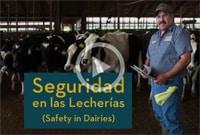- « Back to Database Search
-

-
Immigrant Dairy Workers - A Training Model for Health and Safety on the Farm
-

-
Producers and workers alike highlight a successful health and safety model for immigrant workers in dairy that incorporates an OSHA-approved, train-the-trainer curriculum and utilizes Promotores de salud, or Community Health Workers on the farm.
The safety training curriculum described includes background sections on each topic, a step-by-step facilitator guide and educational handouts such as comic books to help reinforce safety messages after the training. The curriculum includes visuals appropriate for workers with limited formal education and low levels of literacy either in the form of power point slide presentations or flip charts. Available in English and Spanish.
Watch the embedded video below, or download mp4 (right click and save file).
The curriculum was developed as part of the Seguridad en las Lecherias: Immigrant Dairy Worker Health and Safety project, a partnership between the Migrant Clinicians Network, the National Farm Medicine Center and the Upper Midwest Agriculture Safety and Health Center (UMASH).
You may download each module to view its content or request power point versions or flip charts by visiting www.migrantclinician.org/seguridad.
This video was produced by UMASH. Funding for UMASH is provided through a cooperative agreement from the National Institute for Occupational Safety and Health (NIOSH), U54OH010170. The video is provided for informational and educational purposes only. The video contents are solely the responsibility of the authors and do not necessarily represent the views of CDC/NIOSH or any other funders.
- « Back to Database Search
-
Immigrant Dairy Workers - A Training Model for Health and Safety on the Farm
-

-
Producers and workers alike highlight a successful health and safety model for immigrant workers in dairy that incorporates an OSHA-approved, train-the-trainer curriculum and utilizes Promotores de salud, or Community Health Workers on the farm.
The safety training curriculum described includes background sections on each topic, a step-by-step facilitator guide and educational handouts such as comic books to help reinforce safety messages after the training. The curriculum includes visuals appropriate for workers with limited formal education and low levels of literacy either in the form of power point slide presentations or flip charts. Available in English and Spanish.
Watch the embedded video below, or download mp4 (right click and save file).
The curriculum was developed as part of the Seguridad en las Lecherias: Immigrant Dairy Worker Health and Safety project, a partnership between the Migrant Clinicians Network, the National Farm Medicine Center and the Upper Midwest Agriculture Safety and Health Center (UMASH).
You may download each module to view its content or request power point versions or flip charts by visiting www.migrantclinician.org/seguridad.
This video was produced by UMASH. Funding for UMASH is provided through a cooperative agreement from the National Institute for Occupational Safety and Health (NIOSH), U54OH010170. The video is provided for informational and educational purposes only. The video contents are solely the responsibility of the authors and do not necessarily represent the views of CDC/NIOSH or any other funders.
